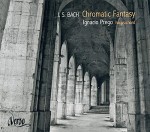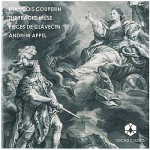Column Name
Title
Bach: Chromatic Fantasy, Toccata in E Minor, Partita No. 2 in C minor, Capriccio sobra la lontananza del fratello dilettissimo. Ignacio Prego, harpsichord. (Verso VRS 2125)
Body
These Bach performances by Historical Performance student Ignacio Prego will attract some listeners for the repertoire and Prego’s artistry, but others may be convinced solely by the sensuous tone of Prego’s harpsichord, a French instrument built by Rafael Marijuan in 2008 and inspired by 18th-century instruments from François-Étienne Blanchet II and Pascal Taskin. There’s a hint of guitar coloring the timbre’s sparkling range. The exceptionally clear recording was made by Federicco Prieto in Madrid’s Auditorio Nicolás Salmerón—though they’re unobtrusive, even the soft thuds of the instrument’s mechanism can be heard.
Bach’s Chromatic Fantasy and Fugue in D Minor (BWV 903) makes an ideal beginning for the recording, which bristles with vitality as Prego effortlessly reveals the composer’s imaginative writing. In the Toccata in E Minor (BWV 91), Prego is perfectly comfortable with the daunting double fugue (Un poco allegro), then relaxes a bit in the intense Adagio before the final Fuga shows the harpsichordist at his most attentive and dramatic.
After a dazzling opening Sinfonia, a festive Rondeaux is a highlight of the Partita No. 2 in C Minor (BWV 826), which demonstrates Prego’s precision, clarity, and agility, plus the instrument’s heady lower voice. And while the final movement, Capriccio, is a complex romp, Prego maintains his cool, carefully executing passages in the midst of Bach’s swarms of notes.
To close, the harpsichordist offers the Capriccio sobra la lontananza del fratello dilettissimo (Capriccio on the Departure of a Beloved Brother), BWV 992, a programmatic work that annotator Enrique Martinez Miura describes as “sadness of separation and warnings against the dangers of travel.” Miura goes on to emphasize Bach’s creativity in representing various elements and moods using ornaments, “strange modulations,” and chromaticism. Prego’s tempo choices are deliberate—not too fast—and he brings out Bach’s rich harmonizations as clearly as if the composer were peering over his shoulder.
Couperin: Pièces de Clavecin, Volume 1: The Tragic Muse. Andrew Appel, harpsichord. (Orchid Classics ORC 100026)
From the more than 230 works contained in Francois Couperin’s Pièces de Clavecin, the B-minor Huitiême Ordre from Book 2 (1716-17) contains unexpected intervals giving the harmonic palette a slight 20th-century edge—an effect that may surprise some listeners. Andrew Appel (D.M.A. ’83, harpsichord) finds drama in the opening Allemande La Raphaéle and in the majestic closing Passacaille, the latter drawing heavily on the instrument’s rumbling lower register. (In each of these Ordres, Appel has reversed the traditional order of the final two pieces.) I especially liked Appel’s taste in the stern second allemande, L’Ausoniéne. The dark, sleek tone of his harpsichord—which was made by Frank Rufkowski and Robert Robinette in Jersey City in 1990 and is a copy of a 1648 model by Johannes Ruckers—ideally suits these 10 small pieces.
In Couperin’s Troisiême Ordre in C Minor from Book 1 (1713), Appel creates a stately mood in the opening, Allemande La Ténébreuse, and later imbues the Sarabande La Lugubre with just the right brush of melancholy. Les Pélerines are a trio of delightful miniatures, full of ornamentation that Appel executes with the precision of a master engraver. Some of the other pieces on the CD—L’Espagnolète, La Lutine, and the joyous Les Matelotes Provençales—show the composer at his most animated, but La Favorite: Chaconne à deux tems gently ends the set on a slightly mournful note.
The lucid recording, by David Walters, was made in St. Mary’s Church in Hudson, N.Y. And on the subject of master engravers, the CD’s cover art—an early 18th-century sample from Appel’s personal collection—shows his discriminating eye. In it, artists Laurent Cars and Jacques Beauvarlet depict actress Hippolyte de la Jude Clairon—looking formidable with a torch in one hand and a dagger in the other—in the role of Médée.






